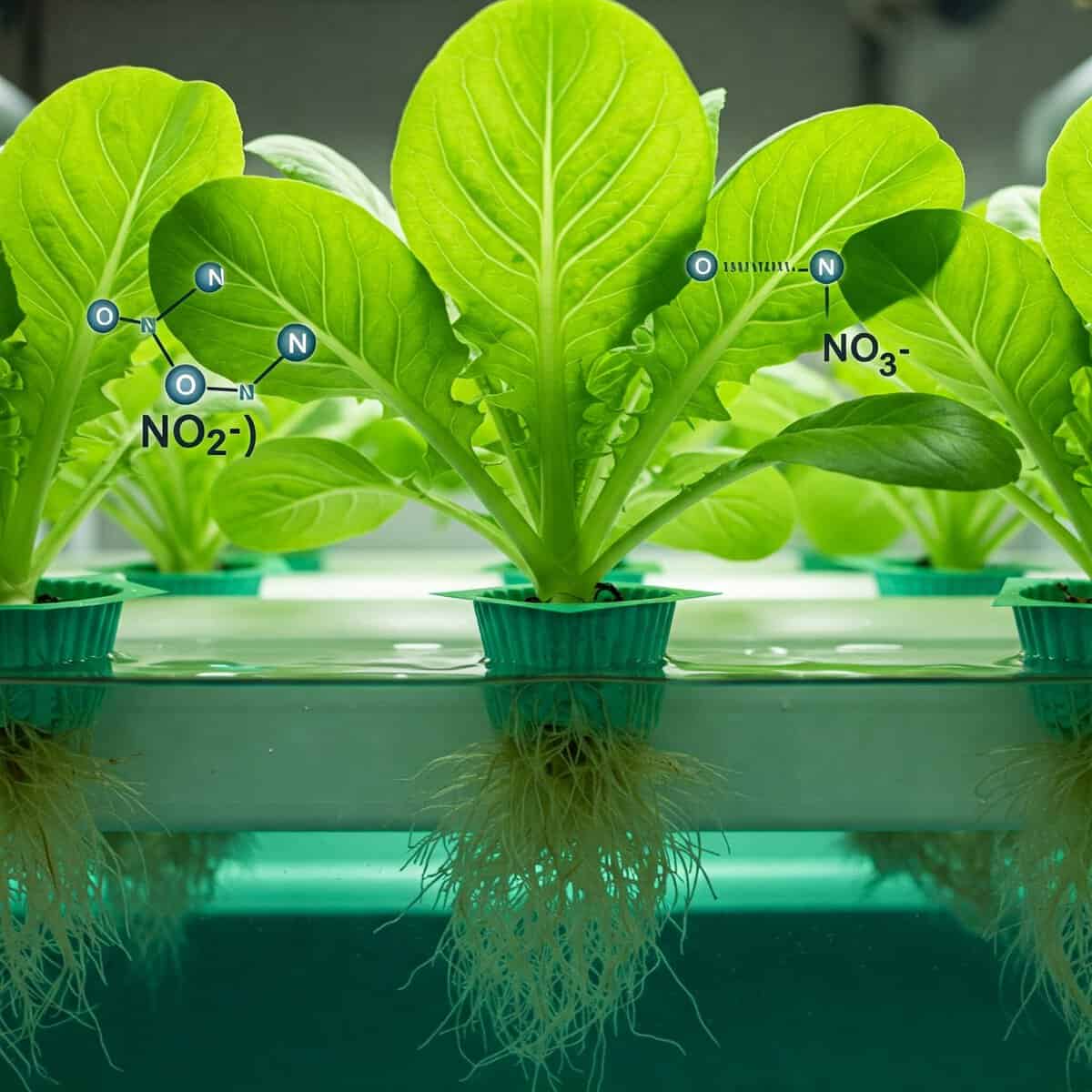Nitrogen forms the backbone of hydroponic plant nutrition, with nitrate and ammonium nitrogen serving distinct roles in plant growth. Nitrate (NO3-) moves freely through plant tissue and creates alkaline conditions, while ammonium (NH4+) gets processed right at the roots and makes the growing environment more acidic.
Plants use both types, but most prefer 80% nitrate to 20% ammonium ratios (though leafy greens might need different amounts). Too much ammonium can hurt plants, causing leaf burn and stunted growth. The right balance between these two nitrogen forms leads to stronger, healthier plants in any hydroponic system.
Key Takeaway
- Nitrate nitrogen helps plants grow strong and compact.
- Ammonium nitrogen can make plants softer and lusher.
- Balance is key; using both types can help plants thrive.
Understanding Nitrogen in Hydroponics
Credit:By Free Entertainment
What is Nitrate Nitrogen?
The sun sets over the small farm, and the cool air marks the transition to evening.The fields are filled with leafy greens like lettuce, spinach, and kale, bathed in the fading light.Nitrate nitrogen (NO3-) is moving among the plants, an invisible, vital nutrient.Plants absorb nitrate easily, using it for rapid growth, without much breakdown.Once inside, nitrate is converted into ammonium (NH4+), used for building proteins essential for cell structure and photosynthesis.(1)
However, nitrate can alter the soil’s pH, making it more alkaline.High alkalinity can affect nutrient uptake, especially for plants that prefer acidic soil, like blueberries.For healthy growth, nitrate should be used in balance, particularly for leafy greens or tomatoes.Regularly check soil pH to avoid excessive alkalinity.Use nitrate fertilizers wisely and watch for signs of nutrient imbalance in plants.
What is Ammonium Nitrogen?
Ammonium nitrogen (NH4+) is an important nutrient for plants, but it requires caution. Here’s what to know:
- Quick Fix: Ammonium provides immediate nitrogen, helping plants in need.
- Too Much: Excess ammonium can burn plants, impair root function, and lead to poor water uptake.
- Soil pH Impact: Ammonium breaks down into hydrogen ions, making the soil more acidic.
- Plant Preferences: Some plants, like blueberries, thrive in acidic soil, while others, like vegetables, prefer neutral pH.
- Balance: Applying too much ammonium can cause nutrient imbalances and harm sensitive plants.
- Signs to Watch: Yellowing leaves and poor growth could indicate too much ammonium.
In short, while ammonium is useful, it’s essential to apply it carefully and monitor your plants for any signs of distress. Keep the soil’s pH and plant preferences in mind for the best results.(2)
Comparing Nitrate and Ammonium
- Absorption
- Nitrate (NO3-) is the preferred form for plants to absorb.
- It’s easily absorbed, promoting fast growth but washed away quickly in rain or watering.
- Ammonium (NH4+) is absorbed just as quickly but remains stable in soil, providing a slow-release nitrogen source.
- pH Impact
- Nitrate increases soil pH, making it more alkaline, which is great for some plants.
- Ammonium lowers soil pH, making it more acidic, ideal for acid-loving plants like blueberries.
- Growth Type
- Nitrate-fed plants grow compact with strong stems, ideal for harsher conditions.
- Ammonium-fed plants have lush, soft leaves but may be more vulnerable to pests.
- Toxicity Threshold
- Excess nitrate causes minor issues like leaf burn but doesn’t usually kill plants.
- Too much ammonium can suffocate roots, leading to nitrogen toxicity and plant death.
- Nutrient Competition
- Nitrate doesn’t interfere with other nutrients’ uptake.
- Ammonium can disrupt nutrient absorption, causing deficiencies.
Practical Tips for Using Nitrogen in Hydroponics
- Toxicity of Ammonium: Ammonium can be harmful in hydroponics. High levels can cause plant stress, wilting, yellowing leaves, and poor growth. Too much ammonium disrupts metabolism, making plants weak and disease-prone.
- Ideal Nitrogen Balance: Aim for 70-80% nitrate in your solution, with ammonium making up 10-20%. Nitrate is easier for plants to process and ensures steady, long-term growth.
- Ammonium’s Role: A mix of ammonium and nitrate provides immediate energy and a slow, sustained nitrogen source. This helps plants grow stronger, improve nutrient uptake, and become more robust.
- Environmental Factors: Temperature and pH affect nitrogen uptake. Warm climates may require less ammonium, while slightly alkaline water can benefit from ammonium to balance pH.
- Know Your Crops: Different plants have different nitrogen preferences. Lettuce might tolerate more ammonium, while tomatoes prefer higher nitrate levels.
Conclusion
Nitrogen and ammonium nitrogen serve distinct purposes in hydroponic plant growth. Plants absorb these nutrients at different rates (NO3- moves faster than NH4+), affecting their development cycles. The pH levels shift as plants take up these compounds – nitrate raises pH while ammonium lowers it. Successful hydroponic growing depends on maintaining proper ratios between 80-90% nitrate and 10-20% ammonium nitrogen, creating optimal conditions for nutrient absorption and plant health.
FAQ
What’s the difference between nitrogen and ammonium nitrogen in hydroponics?
Nitrogen comes in two main forms in hydroponic systems: nitrate (NO3-) and ammonium (NH4+). Plants can use both, but they process them differently. Nitrate nitrogen is more stable and safer for plants. Think of nitrate as a steady, reliable energy source – like eating a balanced meal. Ammonium nitrogen gets absorbed faster but can be tricky to manage, like chugging an energy drink. Too much ammonium can harm your plants, while nitrate is more forgiving.
How do plants absorb these different forms of nitrogen?
Your plants take up nitrate and ammonium through different pathways in their roots. Ammonium gets absorbed right away because it’s positively charged, while nitrate needs some extra work since it’s negative. When plants grab ammonium, they release hydrogen ions, which can make your nutrient solution more acidic. With nitrate, they release hydroxide ions that make things more basic. This is why you’ll often see pH changes in your system depending on which form your plants prefer.
Why do hydroponic nutrients usually contain both forms?
Smart hydroponic nutrient makers include both forms because they complement each other. Having both types helps plants grow better than using just one. Nitrate provides steady nutrition and keeps your system stable, while ammonium gives plants quick access to nitrogen when they need a boost. Plus, using both forms helps maintain a better pH balance in your system since their uptake effects can offset each other.
Can I use just ammonium nitrogen in my hydroponic system?
You really shouldn’t rely on ammonium alone. While plants can grow with just ammonium nitrogen, it’s like trying to live on energy drinks – not a great long-term plan. Too much ammonium can make your solution too acidic and stress out your plants. It can also build up to toxic levels if your system isn’t perfectly maintained. Most experienced growers stick to a mix where nitrate does most of the heavy lifting.
How does temperature affect nitrogen uptake?
Temperature plays a huge role in how your plants handle different forms of nitrogen. When it’s cooler (below 64°F/18°C), plants struggle to process nitrate efficiently. In warmer conditions, they handle nitrate like champs but might get overwhelmed by too much ammonium. This is why commercial growers often adjust their nitrogen ratios seasonally – more ammonium in winter, more nitrate in summer.
What happens if I have too much ammonium nitrogen?
Too much ammonium can wreak havoc in your system. You might notice your plants looking stressed – smaller leaves, weak stems, and burnt-looking roots. It’s like giving them too much caffeine. High ammonium levels can also throw off your pH, making it crash quickly. Plus, beneficial bacteria that help convert ammonium to nitrate can get overwhelmed, leading to a buildup of harmful compounds.
How do I know which form of nitrogen my plants prefer?
Different plants have different nitrogen preferences, just like people have different food preferences. Leafy greens like lettuce and spinach usually do better with more nitrate. Fruiting plants like tomatoes and peppers often appreciate a bit more ammonium during their vegetative stage. The best way to learn is to watch your plants – they’ll show signs if they’re not happy with the nitrogen balance.
Do I need to adjust nitrogen forms for different growth stages?
Yes, your plants’ nitrogen needs change as they grow up. During early growth, they often respond well to a slightly higher ratio of ammonium nitrogen – it helps with leaf and stem development. As plants mature and start producing flowers or fruits, they typically prefer more nitrate nitrogen. Think of it like changing a baby’s diet as they grow into a toddler.
References
- https://scienceinhydroponics.com/2009/02/nitrogen-fertilization-in-hydroponics.html
- https://www.researchgate.net/post/Difference_Between_Ammonium_N_and_Nitrate_N_Source_in_Plant_Nutrition_and_Fruit_Brix_Level
Related Articles
- https://tophydroponicgarden.com/essential-hydroponic-nutrients-list/
- https://tophydroponicgarden.com/best-nutrients-for-leafy-greens/
- https://tophydroponicgarden.com/organic-nutrients-for-hydroponics/
Was this helpful?

I’m Barrie L., a passionate hydroponic gardening enthusiast dedicated to cultivating thriving, soil-less gardens. With a focus on all things hydroponic, I share my expertise on innovative growing techniques and sustainable practices through my blog, tophydroponicgarden.com. As a seasoned hydroponics specialist, my goal is to inspire and guide fellow gardeners in harnessing the power of water-based cultivation for bountiful and eco-friendly harvests. I’m also an author of the book “Hydroponics For Absolute Beginners: Your Step By Step Guide For How To Create An Hydroponics System At Home Without Soil, For Growing Vegetable, Fruit And Herbs.” which is sold on Amazon. Join me on a journey of redefining the way we cultivate plants, one nutrient-rich solution at a time. Happy growing!


